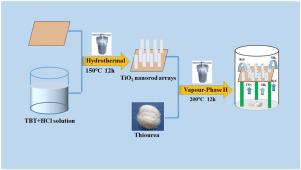Journal of Industrial and Engineering Chemistry ( IF 6.1 ) Pub Date : 2021-03-19 , DOI: 10.1016/j.jiec.2021.03.021 Hai Yu , Miao Zhang , Yanfen Wang , Janguo Lv , Yanmei Liu , Gang He , Zhaoqi Sun

|
In this study, a material with high photocatalytic activity was synthesized using ternary C/N/S-doped TiO2 nanorod array (TiO2); this was done using a practical and straightforward vapor-phase hydrothermal (VPH) method at a low temperature. The effect of C/N/S content on TiO2 morphology, optical, photocatalytic and photoelectrochemical (PCE) properties of the material was investigated by varying the quality of thiourea. C/N/S-TiO2 reduced the bonding rate of electron-hole pairs and enhances visible light absorption, photocatalytic, and PCE properties. The C/N/S doping could significantly adjust the absorption cut-off wavelengths (407−602 nm) and shorten the bandgap (3.04−2.18 eV) of TiO2. Under simulated sunlight, 8-C/N/S-TiO2 had the highest photocatalytic efficiency of 97.6% for methylene blue (MB) in 150 min with a rate constant of 0.0192 min−1, which is approximately four times that of TiO2 (0.005 min−1). The 8-C/N/S-TiO2 photoelectrode had the lowest transfer resistance for interfacial charges and highest transient photocurrent of 33.5 μA/cm2, which is five times higher than that of TiO2 (6.6 μA/cm2). The 8-C/N/S-TiO2 exhibits the most extensive PCE behavior as a photoelectrode, and has a current density of 38.2 mA/cm2 at 2.5VRHE, which is about two times higher than TiO2 (19.1 mA/cm2). The favorable sunlight-driven photocatalytic activity is probably due to the synergistic effect of C/N/S-doping, which shifts the valence band maximum of TiO2 upward. This provides new ideas for future solar cells that can use dye-sensitized TiO2 nanorod arrays as photoanodes. It is noteworthy that VPH is a very effective strategy for fabricating semiconductors doped with multiple nonmetallic elements.
中文翻译:

气相水热合成C \ N \ S掺杂的TiO 2纳米棒阵列的低温策略,具有增强的光电化学和光催化活性
在这项研究中,使用三元碳/氮/硫掺杂的TiO 2纳米棒阵列(TiO 2)合成了具有高光催化活性的材料。这是在低温下使用实用且直接的气相水热(VPH)方法完成的。通过改变硫脲的质量,研究了C / N / S含量对材料的TiO 2形态,光学,光催化和光电化学(PCE)性能的影响。C / N / S-TiO 2降低了电子-空穴对的键合速率,并增强了可见光吸收,光催化和PCE性能。C / N / S掺杂可以显着调节TiO 2的吸收截止波长(407-602 nm)并缩短带隙(3.04-2.18 eV)。在模拟阳光下,8-C / N / S-TiO 2在150 分钟内对亚甲基蓝(MB)的光催化效率最高,为97.6%,速率常数为0.0192 min -1,约为TiO 2的四倍。(0.005 分钟-1)。8-C / N / S-TiO 2光电极的界面电荷转移电阻最低,瞬态光电流最高,为33.5μA / cm 2,是TiO 2( 6.6μA/ cm 2)的五倍。8-C / N / S-TiO 2作为光电极表现出最广泛的PCE行为,并且电流密度为38.2 在2.5V RHE下的mA / cm 2约为TiO 2(19.1 mA / cm 2)的两倍。有利的阳光驱动的光催化活性可能是由于C / N / S掺杂的协同效应,它使TiO 2的价带最大值向上移动。这为可以使用染料敏化的TiO 2纳米棒阵列作为光阳极的未来太阳能电池提供了新思路。值得注意的是,VPH是制造掺有多种非金属元素的半导体的一种非常有效的策略。



























 京公网安备 11010802027423号
京公网安备 11010802027423号